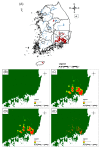Genetic Diversity and Population Structure of Nutria (Myocastor coypus) in South Korea
- PMID: 31861229
- PMCID: PMC6940949
- DOI: 10.3390/ani9121164
Genetic Diversity and Population Structure of Nutria (Myocastor coypus) in South Korea
Abstract
The nutria (Myocastor coypus) is an invasive alien species that have had major adverse effects on biodiversity and the agricultural economy in wetland habitats. Since 2014, the Ministry of Environment in South Korea has been carrying out the Nutria Eradication Project, and we investigated nutria distribution and genetic diversity of nutria populations in South Korea. We estimated that 99.2% of nutria habitats are in the mid-lower Nakdong River regions. To further analyze the genetic diversity in eight major nutria populations, we performed a genetic analysis using microsatellite markers. Genetic diversity levels of the eight nutria populations in South Korea were relatively lower than those in other countries. The probability of migration direction among nutria populations was predicted from genetic distance analysis. Genetic structure analysis showed little difference among the nutria populations in South Korea. These results suggest that nutrias in South Korea originated from a single population. Our results provide important data for establishing management strategies for the successful eradication of nutria populations in South Korea, as well as in other countries with alien invasive species.
Keywords: Myocastor coypus; genetic diversity; invasive species; nutria; population structure.
Conflict of interest statement
The authors declare that they have no conflict of interest.
Figures





Similar articles
-
Climate change induced habitat expansion of nutria (Myocastor coypus) in South Korea.Sci Rep. 2022 Feb 28;12(1):3300. doi: 10.1038/s41598-022-07347-5. Sci Rep. 2022. PMID: 35228626 Free PMC article.
-
Radio Tracking Reveals the Home Range and Activity Patterns of Nutria (Myocastor coypus) in the Macdo Wetland in South Korea.Animals (Basel). 2023 May 22;13(10):1716. doi: 10.3390/ani13101716. Animals (Basel). 2023. PMID: 37238145 Free PMC article.
-
Habitat suitability and connectivity modeling predict genetic population structure and priority control areas for invasive nutria (Myocastor coypus) in a temperate river basin.PLoS One. 2022 Dec 16;17(12):e0279082. doi: 10.1371/journal.pone.0279082. eCollection 2022. PLoS One. 2022. PMID: 36525436 Free PMC article.
-
Development of microsatellite markers and the genetic diversity of Myocastor coypus introduced to South Korea.J Vet Med Sci. 2019 Mar 30;81(3):499-503. doi: 10.1292/jvms.18-0564. Epub 2019 Feb 1. J Vet Med Sci. 2019. PMID: 30713217 Free PMC article.
-
A review of productive parameters, nutritive value and technological characteristics of farmed nutria meat (Myocastor coypus).Meat Sci. 2019 Feb;148:137-149. doi: 10.1016/j.meatsci.2018.10.006. Epub 2018 Oct 9. Meat Sci. 2019. PMID: 30388478 Review.
Cited by
-
Climate change induced habitat expansion of nutria (Myocastor coypus) in South Korea.Sci Rep. 2022 Feb 28;12(1):3300. doi: 10.1038/s41598-022-07347-5. Sci Rep. 2022. PMID: 35228626 Free PMC article.
-
Radio Tracking Reveals the Home Range and Activity Patterns of Nutria (Myocastor coypus) in the Macdo Wetland in South Korea.Animals (Basel). 2023 May 22;13(10):1716. doi: 10.3390/ani13101716. Animals (Basel). 2023. PMID: 37238145 Free PMC article.
-
New insights into predator-prey dynamics: First evidence of a leopard cat hunting coypus.Ecol Evol. 2024 Feb 13;14(2):e11016. doi: 10.1002/ece3.11016. eCollection 2024 Feb. Ecol Evol. 2024. PMID: 38352206 Free PMC article.
-
Habitat suitability and connectivity modeling predict genetic population structure and priority control areas for invasive nutria (Myocastor coypus) in a temperate river basin.PLoS One. 2022 Dec 16;17(12):e0279082. doi: 10.1371/journal.pone.0279082. eCollection 2022. PLoS One. 2022. PMID: 36525436 Free PMC article.
-
Spatial Movement Patterns and Local Co-Occurrence of Nutria Individuals in Association with Habitats Using Geo-Self-Organizing Map (Geo-SOM).Biology (Basel). 2021 Jun 28;10(7):598. doi: 10.3390/biology10070598. Biology (Basel). 2021. PMID: 34203361 Free PMC article.
References
-
- Simberloff D. Rats are not the only introduced rodents producing ecosystem impacts on islands. Biol. Invasions. 2009;11:1735–1742. doi: 10.1007/s10530-008-9400-5. - DOI
-
- Woods C.A., Howland E.B. Adaptive radiation of capromyid rodents: Anatomy of the masticatory apparatus. J. Mammal. 1979;60:95–116. doi: 10.2307/1379762. - DOI
-
- Bounds D. Nutria: An invasive species of national concern. Wetl. J. 2000;12:9–16.
Grants and funding
LinkOut - more resources
Full Text Sources

